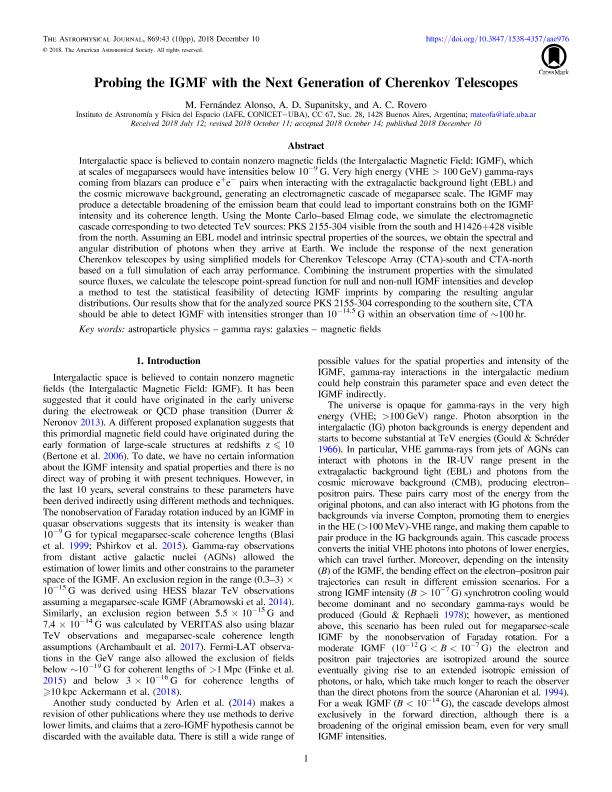Mostrar el registro sencillo del ítem
dc.contributor.author
Fernandez Alonso, Mateo

dc.contributor.author
Supanitsky, Alberto Daniel

dc.contributor.author
Rovero, Adrian Carlos

dc.date.available
2019-10-18T15:43:15Z
dc.date.issued
2018-12
dc.identifier.citation
Fernandez Alonso, Mateo; Supanitsky, Alberto Daniel; Rovero, Adrian Carlos; Probing the IGMF with the Next Generation of Cherenkov Telescopes; IOP Publishing; Astrophysical Journal; 869; 1; 12-2018; 1-10
dc.identifier.issn
0004-637X
dc.identifier.uri
http://hdl.handle.net/11336/86358
dc.description.abstract
Intergalactic space is believed to contain nonzero magnetic fields (the Intergalactic Magnetic Field: IGMF), which at scales of megaparsecs would have intensities below 10-9 G. Very high energy (VHE > 100 GeV) gamma-rays coming from blazars can produce e+e- pairs when interacting with the extragalactic background light (EBL) and the cosmic microwave background, generating an electromagnetic cascade of megaparsec scale. The IGMF may produce a detectable broadening of the emission beam that could lead to important constrains both on the IGMF intensity and its coherence length. Using the Monte Carlo-based Elmag code, we simulate the electromagnetic cascade corresponding to two detected TeV sources: PKS 2155-304 visible from the south and H1426+428 visible from the north. Assuming an EBL model and intrinsic spectral properties of the sources, we obtain the spectral and angular distribution of photons when they arrive at Earth. We include the response of the next generation Cherenkov telescopes by using simplified models for Cherenkov Telescope Array (CTA)-south and CTA-north based on a full simulation of each array performance. Combining the instrument properties with the simulated source fluxes, we calculate the telescope point-spread function for null and non-null IGMF intensities and develop a method to test the statistical feasibility of detecting IGMF imprints by comparing the resulting angular distributions. Our results show that for the analyzed source PKS 2155-304 corresponding to the southern site, CTA should be able to detect IGMF with intensities stronger than 10-14.5 G within an observation time of ∼100 hr.
dc.format
application/pdf
dc.language.iso
eng
dc.publisher
IOP Publishing

dc.rights
info:eu-repo/semantics/openAccess
dc.rights.uri
https://creativecommons.org/licenses/by-nc-sa/2.5/ar/
dc.subject
ASTROPARTICLE PHYSICS
dc.subject
GAMMA RAYS: GALAXIES
dc.subject
MAGNETIC FIELDS
dc.subject.classification
Astronomía

dc.subject.classification
Ciencias Físicas

dc.subject.classification
CIENCIAS NATURALES Y EXACTAS

dc.title
Probing the IGMF with the Next Generation of Cherenkov Telescopes
dc.type
info:eu-repo/semantics/article
dc.type
info:ar-repo/semantics/artículo
dc.type
info:eu-repo/semantics/publishedVersion
dc.date.updated
2019-10-17T19:10:51Z
dc.journal.volume
869
dc.journal.number
1
dc.journal.pagination
1-10
dc.journal.pais
Reino Unido

dc.journal.ciudad
Londres
dc.description.fil
Fil: Fernandez Alonso, Mateo. Consejo Nacional de Investigaciónes Científicas y Técnicas. Oficina de Coordinación Administrativa Ciudad Universitaria. Instituto de Astronomía y Física del Espacio. - Universidad de Buenos Aires. Facultad de Ciencias Exactas y Naturales. Instituto de Astronomía y Física del Espacio; Argentina
dc.description.fil
Fil: Supanitsky, Alberto Daniel. Consejo Nacional de Investigaciónes Científicas y Técnicas. Oficina de Coordinación Administrativa Ciudad Universitaria. Instituto de Astronomía y Física del Espacio. - Universidad de Buenos Aires. Facultad de Ciencias Exactas y Naturales. Instituto de Astronomía y Física del Espacio; Argentina
dc.description.fil
Fil: Rovero, Adrian Carlos. Consejo Nacional de Investigaciónes Científicas y Técnicas. Oficina de Coordinación Administrativa Ciudad Universitaria. Instituto de Astronomía y Física del Espacio. - Universidad de Buenos Aires. Facultad de Ciencias Exactas y Naturales. Instituto de Astronomía y Física del Espacio; Argentina
dc.journal.title
Astrophysical Journal

dc.relation.alternativeid
info:eu-repo/semantics/altIdentifier/doi/https://doi.org/10.3847/1538-4357/aae976
Archivos asociados
